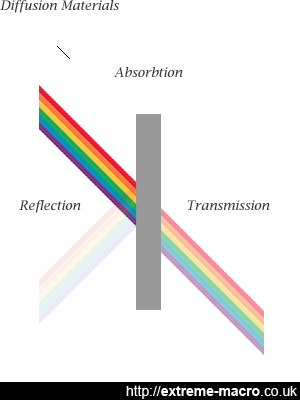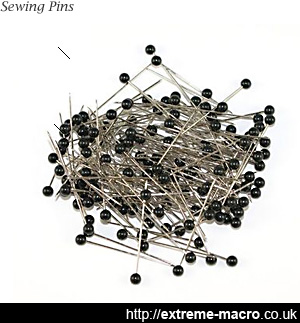Measuring Diffusion
by Johan J Ingles-Le Nobel
Last updated August 31, 2017
When light travels through a material it does one of three things. Some of the light either is bounced back, some of the light is absorbed inside the material and disappears, and some of the light makes it through to the other side.
When it comes to diffusion, each of these properties matter, and monitoring the different values for each may help you understand why the material that you use behaves the way that it does.

As light travels through a material it does one of three things. Some of the light either is bounced back, some of the light is absorbed inside the material and disappears, and some of the light makes it through to the other side.
When it comes to diffusion, each of these properties matter, and monitoring the different values for each may help you understand why the material that you use behaves the way that it does
Reflection
Whilst it obviously matters when using a reflector for your diffusion, reflection isn't the most important factor when it comes to understanding transmitted diffusion. What is interesting about reflected diffusion however, is that there is a scale of effects, from shiny metal foil that produces the least amount of reflected diffusion (reflections will be very specular) to white coloured material, which produces a diffusion with the most gradual fall off. Fall off in the sense of edge fringe rather than conventional fall off from the inverse square law.
Absorption
Light absorption isn't something I specifically look for when looking at diffusion materials. As photographers we don't want our flash light to be absorbed by the diffusion material because it means higher manual flash settings, therefore slower flash speeds and more battery use. On the other hand there is a correlation between absorption and internal scattering. Internal scattering is actually good because it means that when the light comes out the other side it will be nice and spread out rather than being in straight lines and hard.
Having said that I've frequently noticed that the amount of light a material absorbs also acts as a type of barrier to make sure that your diffuser doesn't have a harsh hotspot and burn out part of your image. I believe that what happens is that once materials go beyond a certain density they can only put out a certain brightness of diffused light, regardless of whether the flash on the other side is set at 1/16 or 1/1.
Transmission

Shiny black dress making pins of the fetching 4mm variety. Awesome for testing out diffusion.
Shoot a shiny sewing pin, and it will reflect your diffuser and show you what the light looks like from the object being photographed's point of view. This little test is also a handy way to see the black hole that the reflection of your lens will probably make in the diffuser
High transmission materials don't make for great diffusion materials mainly because they tend to give you the very hotspots that you're trying to avoid. For example the frosted plastic covers of paper folders, you might think that these would make for good diffusion material but in my experience they actually let through too much light. Therefore the pattern of light seen from the perspective of the object being photographed is not even but emanates from a source that can be identified, which is not the ideal light. One way to ameliorate this is by having a multi-ply structure, ie several sheets on top of each other. This has worked well for me with tracing paper, for which the transmission is too high to be used as a diffusion material. It is, unfortunately, difficult to measure diffusion without scientific instruments so there are two techniques that I use to make a rough and ready test of your diffusion.
Softer Transmission - Scatter
A problem that we get with high transmission material is harsh hotspots and overly contrasty lighting. Take for example glass, which is optically clear so the highest possible transmission. There's no diffusion going on so the shadows are lines, with a clear differential between shadow and lit. What we want is a very different type of light, that is not in a straight line from the flashhead so no straight line shadows, and that reaches into every dark area because it comes from a lot of different directions. So a very important sub property of your diffusion material is how much scatter it produces, ie if the diffuser is a large sheet, the light should look as if it comes from the whole sheet, not just a hotspot showing because of the flash behind. Polystyrene has superb scatter and is cheap and easy to find, so is tissue paper and so is multiple layers of tracing paper.
How To Test Diffusion
Besides looking on test shots of the object, I use two other ways to test diffusion before using it. The first is extremely obvious, a shot in the mirror of the diffuser. I find it very useful to try and use the lowest setting possible as this will give you the best edge to edge performance shot of your diffusion in action. What I like to see is a uniformly shaded diffuser, with the same light value at the very edges as in the centre.
The second test I do is even simpler, a shot of a simple black plastic spherical sewing pin. The sewing pin will reflect your diffuser and show you what the light looks like from the object being photographed's point of view. This little test is a great way to see the black hole that the reflection of your lens will probably make in the diffuser, unless of course you use an angled piece of glass to eliminate this.
How To Measure Diffusion
Whilst there is no recognised standard to measure diffusion in the photographic arts, the construction industry has a standard that can be adopted, namely Light diffusing power. There is such a thing as the LEE Diffusion Index (LDI) which Lee filters created to enable comparison of diffusion capabilities across their own Lee range, and whilst this has useful information such as transmission (Y%) for their products, it doesn't cover scatter beyond a sliding more and less scale, nor does it compare to other materials.
Measuring diffusion is definitely something I'd like to come back to at a later stage as I think it's about time that we found some way to accurately and consistently measure this stuff, wouldn't you say? - Otherwise it's just endless guessing. We know that 3 factors matter: absorption, transmission, reflection and they've somehow got to be combined into something that takes account of where the light is coming from... hmmm
Related Articles



